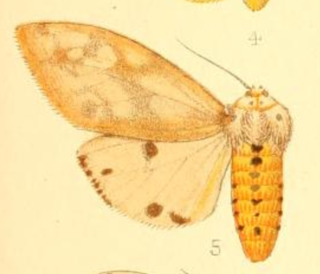Mometa is a genus of moths in the family Gelechiidae.

Spilosoma batesi is a moth of the family Erebidae. It was described by Walter Rothschild in 1910. It is found in Nigeria, Cameroon, Congo and Zaire.

Polydesma umbricola, the monkeypod moth or large tabby, is a species of moth in the family Erebidae. The species is found in southern Europe, Africa, Asia Minor to southern Asia, of India, Sri Lanka, Maldives, the Andaman Islands, including many Indian Ocean islands, like Coëtivy Island, Aldabra, Assumption Island, Madagascar and on Hawaii.

Callopistria latreillei, Latreille's Latin, is a moth of the family Noctuidae. The species can be found in the Palearctic realm, most parts of Europe, Asia, and in Africa from Egypt to South Africa. The habitat consists of rocky limestone slopes with deciduous woodland.

Spilosoma rava is a moth in the family Erebidae. It was described by Herbert Druce in 1898. It is found in Cameroon, the Democratic Republic of the Congo, Equatorial Guinea, Gabon, Ghana, Kenya, Liberia, Nigeria, Senegal, the Gambia and Uganda.
Jim Williams is a Welsh professional darts player who plays in Professional Darts Corporation (PDC) events.
Dichomeris ventosa is a species of moth in the family Gelechiidae. It was described by Edward Meyrick in 1913. It is found in Mpumalanga, South Africa.
Dichomeris oenombra is a moth in the family Gelechiidae. It was described by Edward Meyrick in 1914. It is found in Malawi and South Africa.
Helcystogramma septella is a moth in the family Gelechiidae. It was described by Philipp Christoph Zeller in 1852. It is found in Malawi, South Africa, Tanzania and the Gambia.
Gelechia sematica is a moth of the family Gelechiidae first described by Edward Meyrick in 1913. It is found in Namibia and South Africa.
Ephysteris sirota is a moth in the family Gelechiidae. It was described by Edward Meyrick in 1908. It is found in the South Africa provinces of Gauteng, KwaZulu-Natal and Limpopo.
Scrobipalpa concreta is a moth in the family Gelechiidae. It was described by Edward Meyrick in 1914. It is found in South Africa and the former Orientale Province of the Democratic Republic of the Congo.
Octonodula inumbrata is a moth of the family Gelechiidae. It was described by Edward Meyrick in 1914. It is found in South Africa.
Mometa chlidanopa is a moth of the family Gelechiidae. It was described by Edward Meyrick in 1927. It is found in Uganda.
Mometa infricta is a moth of the family Gelechiidae. It was described by Edward Meyrick in 1916. It is found in Malawi.
Lecithocera cucullata is a moth in the family Lecithoceridae. It was described by Edward Meyrick in 1914. It is found in Mozambique.
Lecithocera strigosa is a moth in the family Lecithoceridae. It was described by John Hartley Durrant in 1915. It is found on New Guinea.
Cophomantella crypsizyga is a moth in the family Lecithoceridae. It was described by Edward Meyrick in 1914. It is known from Malawi.
Crocanthes crypsichola is a moth in the family Lecithoceridae. It was described by John Hartley Durrant in 1915. It is found on New Guinea.
Crocanthes fallax is a moth in the family Lecithoceridae. It was described by John Hartley Durrant in 1915. It is found on New Guinea.


